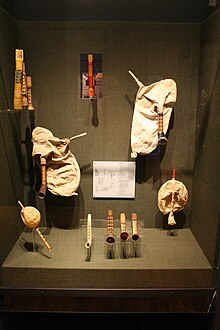Tsambouna
Tsambouna ( Greek Τσαμπούνα ), also tsampouna , tsampounofylaka , askomadoùra or touloum (see tulum ), is a bagpipe that is mainly found on the Greek islands, among Greeks with origins from the Black Sea region ( Pontos Greeks ) and occasionally on the mainland. Unlike mainly in Thrace and Macedonia spread gaida she has no Bordunrohr .
Construction
The tsambouna is made from locally available natural materials by the player himself or by a villager who specializes in it. A sheepskin or goatskin, which is turned over, serves as an air reservoir.
The doubled play tubes of approx. 25 cm length are made of olive wood, reed or bone . The sound is generated by two single reeds that are inserted into the chanter with a reed holder. One of the two play tubes has five, the other, depending on its origin, one to five finger holes (5 + 5 on the Cyclades and Crete , 5 + 3 on Kalymnos and Astypalea , 5 + 1 on Patmos , Samos , Chios and Ikaria ).
The blowing pipe made of wood or pipe is cylindrical or conical and 12 cm long. Ornaments can be carved or burned in with a hot iron.
Style of play
Because of its small range, the tsambouna has its own limited repertoire. As with all bagpipes, the air flow from the bellows can hardly be varied and plays a subordinate role in accentuating the melody.
The scale is diatonic . Since the tsambouna is not made by professional instrument makers, each instrument has its own tuning. This creates difficulties when playing with other instruments. Usually the tsambouna is accompanied by just one drum, the daoulaki , a smaller variant of the Greek daouli ( davul in Turkey ). On the islands of the Dodecanese , especially on Karpathos , lyra and tsambouna play the melody, accompanied by the lute laouto .
Suggestions and trills are performed to make the melody rhythmic . The finger holes of the parallel chanter are covered by the same finger. Since the two playing tubes are not completely in tune, there are beats that amplify the tone and that are characteristic of the tsambouna .
This beat principle (also beat diafony) is a special form of polyphony in the Balkans, as it is known, for example, in southern Albania as iso-polyphony . Only on the island of Karpathos is there a two-part diafone song of women, which has developed from the imitation of the tsambouna double whistle. The Dalmatian double flute dvojnice (also known as diple ) and the Balkan double reed instrument sopele produce similar floating sounds .
The tsambouna is used to play traditional music of the shepherd communities. Due to its penetrating sound, it is ideal for playing outside for dancing. The continued existence of the instrument is in jeopardy today because its sound and repertoire do not correspond to modern listening habits.
Related instruments
Tulum , Diple , Żaqq , Mezwed , Boha , without air bag: Alboka
Discography
- Bagpipes of Greece. Recordings and commentary by Wolf Dietrich. Topic Records, London 2005 (TSCD930), tracks 15-22, 25-28
Web links
- Tsambouna, Museum of Greek Folk Musical Instruments , Greek
- Astrid Scharlau, Nikos Mandilaras: Tsambouna - the Greek bagpipes.
Individual evidence
- ↑ Rudolf M. Brandl : The "Schwebungsdiafonie" in Epiros and related styles in the light of psychoacoustics. In: Rüdiger Schumacher (ed.): From the diversity of musical culture. Festschrift for Josef Kuckertz . At the end of the 60th year of life. (Word and music. Salzburg academic contributions) Ursula Müller-Speiser, Anif / Salzburg 1992, p. 57

